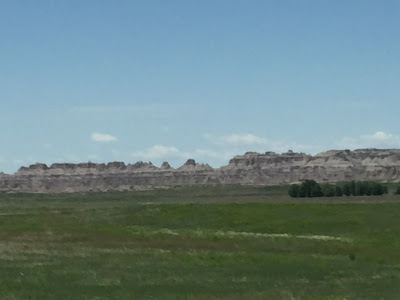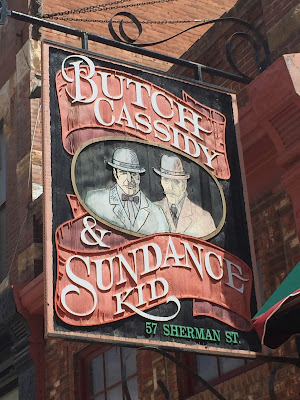The slogan for the National Park system, that is celebrating 100 years this year, is Find Your Park. We traveled through 21 states on our RV trip and visited at least 12 national parks and monuments! The big finish of our western tour was in South Dakota. We camped in Rapid City for a few days and spent three days checking out the sights. (By this time I needed a laundry and cleanup day, so we stayed one extra day just to take care of household chores.)
South Dakota isn't as awe-inspiring as Utah, but the corner we were in had some amazing places and beautiful sights, from wildflowers by a stream,
to rugged, barren rock.
We spent one day driving through the Badlands, and ending at a well-known tourist spot, Wall Drug.
The story behind Wall Drug was unknown to me. I am always in search of inspiring stores, so I found this one very interesting.
The town of Wall, SD is so-named because it lies at the base of rocky cliffs that rise from the prairie like a wall.
The Husteads moved there in 1931 hoping to make a go of running a drug store. Business was slow, but they hoped when Mt. Rushmore opened business would boom. Unfortunately, it didn't. 5 years later they were listening to the cars on the highway driving right by, without stopping in town. One afternoon, Dorothy had an idea---to advertise free ice water. They put signs on the highway, like the little Burma Shave signs, that directed people to Wall Drug for a FREE glass of ice water.
They've been busy ever since and they still offer free ice water. The drug store has grown way beyond it's original size. Once inside the 76,000 square foot complex there are many smaller stores selling everything from t-shirts to lovely paintings.
A restaurant, arcade, and a chapel for those needing a quiet respite, are just a few of the things you will find there.
Wall, SD is at the western end of the Badlands. I've always heard about the Badlands but I had never been there so I was intrigued. In truth, I've seen many places on this trip that would be most intimidating to me as a traveler in the 1800's. The name came from the Lakota people who called this area, "Mako Sica", which translated, meant Land Bad. And if I had to travel through here on horseback or wagon, I would have agreed!
 |
| These formations looked like sand castles. |

The second day we were in Rapid City, we took the northern route and traveled up to Deadwood, a reinvented ghost town.
Deadwood was originally a mining town that stood along a creek. I am always intrigued by the names of developments that spring up today, with names like "Cypress Creek", or "Whispering Pines" (where there is no creek to be found and any tree that existed has long since been removed in order to build homes). The name Deadwood derives not from someone's imagination, but because the gulch where gold was found was lined with dead trees. Miners in search of gold would know right away they had found the right area when they saw all the dead wood. The hills come right down to the creek's edge and the town simply climbed its sides. The town had one of the most productive gold mines for over 100 years. In the 1980's as the town store fronts lay vacant the residents decided to redefine the town. Town promoters were able to get a state constitutional amendment that allowed limited stakes gambling. Many of the old saloons have been rebuilt and refurbished to be saloons with casinos. To further celebrate their history, they reenact gun fights daily and hold frontier celebrations throughout the year.
On our last day in this area we drove the scenic routes around Mt. Rushmore, which is located just outside Rapid City. The Peter Norbeck National Scenic Byway, which includes Iron Mountain Road and Needles Highway, forms a loop that grants views of Mt. Rushmore and encompasses some of the most awe-inspiring vistas. Probably the most creative and unsuual road we've ever driven was the Peter Norbeck National Scenic Byway. As described in its website, "South Dakota conservationist, Governor and U.S. Senator Peter Norbeck wanted to share the unspoiled beauty of the Black Hills with others. But it was of utmost importance to him to do it responsibly. The result is a 68-mile series of twisting roads that carefully tiptoe through the Harney Range of the central Black Hills, leaving very little impact on the surrounding environment. You won’t find a comparable scenic byway anywhere else in the country because Peter Norbeck was the only person bold enough to challenge the engineers of the time who said it couldn’t be done."
The byway is full of narrow, tight turns and tunnels through the mountain. Among Norbeck's achievements in developing this road was the alignment of three one-lane tunnels through the mountain so that they were positioned to give the traveler a clear view of Mt. Rushmore.
Coming through this tunnel, Mt. Rushmore can be viewed through the trees.
 |
| Same view as above. |
Norbeck was also known for designing 'Pigtail' bridges, in which the road looped over itself.
From the scenic byway, the road continues on to the Iron Mountain Road, and then loops around Custer National Park. The end of the loop drive is through the Needles region, which showcases tall spires and columns of rock.
One of the tunnels just fits a full size tourist bus. The tunnel is 8'4" wide. The bus is 8' wide! We were behind one bus as it approached the tunnel and I was hoping to see it as it squeezed through the tunnel. However, the driver pulled over to let the line of traffic behind him, through first. The next day I spoke with a woman who had been on the bus and she described the driver as he hammed it up for the cameras, holding up a bottle of maalox and a sign that said Learner Driver. Two videos on YouTube show this unique drive. The first one ,3 minutes long, is a nice view of Needles area. The second one shows the bus growing through the tunnel. It is 8 minutes long, but fun to watch.
It was this area that was the original brainstorm of Mt. Rushmore. A local historian, Doane Robinson, had the idea of carving Wild West heroes into the tall granite columns as a tourist attraction. However, when the sculptor, Gutzon Borglum, inspected the rocks he said they were too fragile for such an undertaking. At the time, Borglum was working on Stone Mountain in Georgia. He believed that the project should be grander than Robinson's vision. He wanted to create a shrine to democracy and presented the idea of the Presidents. After exploring the area he settled on Mt. Rushmore as having the right type of rock and the best viewing. He chose Washington as the father of the country. Jefferson represented growth because when he purchased the Louisiana Territory it doubled the size of our country. Lincoln preserved the union (because he fought to keep it whole), and Roosevelt represented its conservation and development.
 |
| View of Washington's profile from the Needles Highway |
At the end of this remarkable drive, we visited Mt. Rushmore.
A path goes from the amphitheater, to the base of the monument, affording a variety of different views. It continues on past the sculptor's studio, which was closed when we were there.
We visited as the sun was setting and stayed for the evening program. Every night, a program presents the history of the National Monument and tells about its creation. The faces are lit by floodlights, and all servicemen, retired or active, are invited onto the stage where they are introduced by name, and branch of service. It is a wonderful way to honor those who have stood for the liberty we have been blessed with.
We had an amazing time in South Dakota. We saw a lot, and yet there is so much more there to see. In fact, that pretty well sums up our whole trip. We saw so much of this wonderful country, but we only took in a fraction of what was there. Aside from the history of our own people, I became so much more aware of the history of the original North Americans. The Native American heritage is woven through the history of every state in our country and we were reminded of that.
Find My Park? Well, let's just say we found a bunch of them! Thank you Teddy Roosevelt, and all of the other forward thinking preservationists that recognized "We do not inherit the earth from our ancestors, we borrow it from our children". (Unknown)
"Leave it as it is, the ages have been at work on it, and man can only mar it." Teddy Roosevelt




































